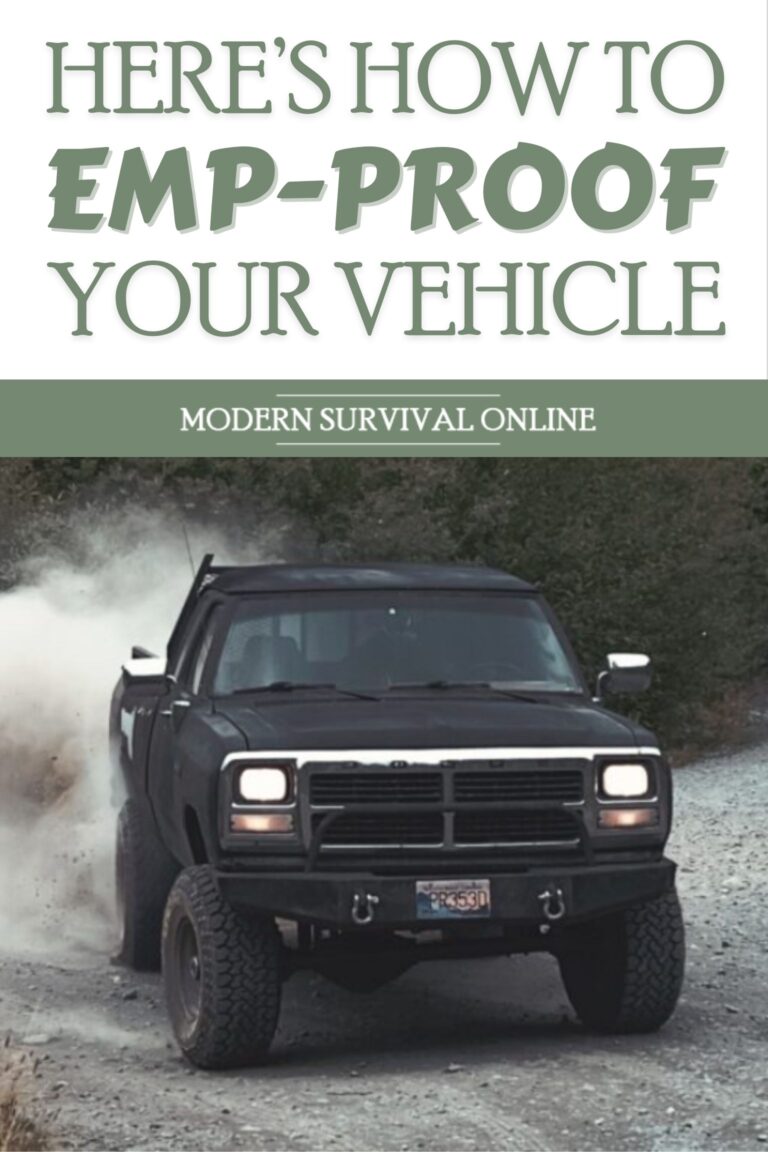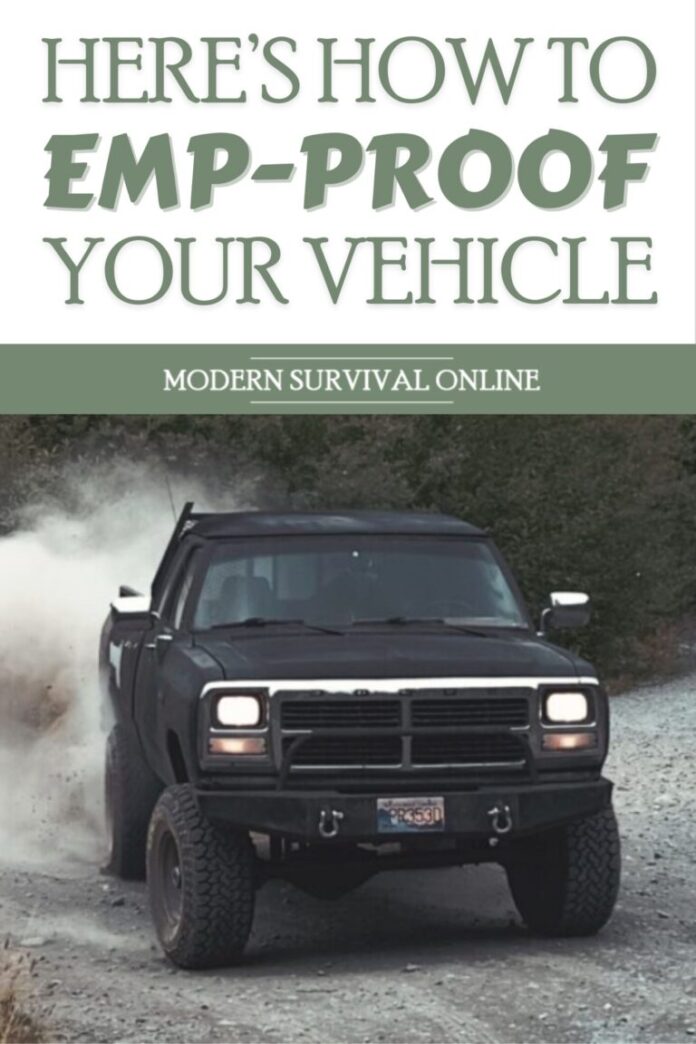One of the hallmarks of being a good prepper is knowing what you’re up against. Understanding the nature of the threat, be it a group of people, a natural disaster or an accidental catastrophe is fundamental to preparing yourself against the consequences.

No matter how big, no matter how scary, there’s always something that can be done to improve your chances…
But one of the biggest and scariest, and also one of the most plausible, society-toppling events facing civilization today is that of an EMP, or electromagnetic pulse.
Created by the detonation of a nuclear bomb or specialty weapon designed for the purpose, any potent EMP can completely wipe out electrical grids, electronics and the many tools and devices that rely on either. This includes many automobiles.
No matter what sort of situation you’re facing, losing your vehicle could be devastating to your chances.
That’s why it’s so important that you learn how to protect it from an EMP in case one does occur, or at least increase the chances that it is repairable in the aftermath. This guide will help you do exactly that.
An EMP is an electromagnetic pulse, a surge of electrical energy that can impart extreme voltages across any conductive material and subsequently cause an overload, short or overheating damage in any vulnerable device.
There are all kinds of EMPs that occur every single day, generated by many different sources. Many are caused by various kinds of electrical equipment, while others are naturally occurring, resulting from lightning strikes.
All have the ability of interfering with various electronics, and sometimes they can be damaging. But, we generally aren’t worried about these everyday and borderline-insignificant EMPs…
We’re worried about the really big ones, the ones that can cause widespread local or even regional damage to electrical grids and most electronics, or anything that depends upon electronics to function, such as our vehicles.
Major EMPs of the type we are concerned with generally come in three varieties: nuclear, non-nuclear and natural.
Nuclear: an EMP that is generated by the detonation of a nuclear warhead. Larger warheads generate a more powerful pulse that radiates out from the point of detonation as waves that can travel a long distance, virtually unimpeded by the air alone.
A nuclear EMP is especially dangerous because it might hamper escape or relief efforts after the blast in an area far outside the primary and secondary effects of the bomb itself.
Non-nuclear: a non-nuclear EMP, abbreviated NNEMP, is one that is created from a specialty EMP-generating device or “bomb”.
These devices can produce the sometimes highly desirable effects of an EMP in a military context without the stigma of actually detonating a nuclear weapon.
For our purposes, these weapons are powerful enough to produce EMPs capable of causing serious regional mayhem.
Natural: major EMPs can also be completely natural occurrences, surprisingly enough. These are typically in the form of cosmic phenomena created by the sun in the form of solar storms, coronal mass ejections and other interstellar events that can affect the entire globe at once.
Usually not as powerful overall compared to nuclear and non-nuclear EMPs, these events may nonetheless be sustained over days or weeks, and can cause serious trouble with electronics and potentially major damage.
Obviously nuclear and non-nuclear EMPs are the most worrying, and frighteningly plausible. That being said, naturally occurring EMPs that had global consequences have happened in recorded history and should be taken seriously.
Look up the Carrington Event for more information.
So we know what an EMP is and where it comes from. How does this affect our vehicles?
Considering that the vast majority of cars on the road today are increasingly dependent upon electronics including for basic operation, EMPs could disable, damage, or destroy our vehicles.
It could burn out circuit boards, damage or destroy fuel injection systems, create malfunctions or destruction of instrumentation and much more.
Depending on the year, brand and model of your car, as well as various design features inherent to it, your vehicle could temporarily malfunction, be rendered inoperable due to damage or be effectively destroyed due to the loss of its critical electronic components.
As a general rule, the more sophisticated and modern your vehicle, the more vulnerable it likely is to an EMP.
Losing your vehicle in any case is going to be a terrible blow under the circumstances, and if you are relying on it to survive a seriously dangerous situation your life could be put in danger.
It’s Uncertain How Much a Powerful EMP Will Actually Affect Your Vehicle
Obviously, you’ll want to protect your vehicle, whatever it is, from the destructive effects of an EMP. However, before we get to the actual nuts and bolts of protecting it, there is a major but little-known controversy that must be addressed.
This “elephant in the room” is simply that the precise nature of the vulnerability of modern vehicles is up for debate.
We know EMPs of the kind we’re talking about are indeed highly destructive, but what we don’t know is just how destructive they are to vehicles, even modern ones.
This is because the private companies that have performed such testing, whether or not at the behest of the federal government, are not telling us the whole story.
Plus, of the tests we do know about might have been corrupted by lobbying from manufacturers or subjected it to seriously flawed testing protocols.
I’ll spare you all of the details but I will link to a relevant story on the matter, and here’s the short version…
Out of all the modern vehicles tested and one of the few laboratories capable of it actually creating the levels of energy were worried about, no vehicle was subjected to testing at the maximum end of the power spectrum.
In addition, all testing, for any model of vehicle, was halted as soon as any failure, malfunction or damage was experienced.
The manufacturers and agencies that supplied those vehicles? No one is talking. Reports from participants or administrators of the tests? At odds, redacted or retracted.
We simply do not know the true extent of automobile vulnerability to EMP, and the people that do know clearly want to keep the public in the dark.
Knowing this, you should act accordingly, but also understand that a large amount of uncertainty must remain no matter what we do to try and protect our vehicles.
With that in mind, let’s finally get on to the actual protection process.
So, after reading all that if you are undaunted and still want to try to EMP-proof your vehicle or just increase its EMP resistance, do the following:
Assess Before You Begin
Before you get taken by any snake oil claims of automotive EMP protection kits or you just want to perform some DIY hardening of your vehicle, you should assess it for vulnerability.
Here’s the rule of thumb for EMP vulnerability assessment: the older the car and the less electronics it has, the less vulnerable it will be to an EMP.
The newer the car, and the more electronics, the more vulnerable it is.
The more knowledge and expert skill you have with automobiles, the better off you will be when making this assessment.
If you know a given make and model of car is basically inoperable without one or more of its computers or other electronics functioning, you can bet your bottom dollar that car is probably toast when an EMP occurs.
Conversely, a car that has precious few electronics and uses a carburetor will probably run just fine immediately after.
These are rules of thumb, and we will talk about exceptions, but if you have a newer vehicle you’re definitely going to have your work cut out for you if you want to EMP-proof it.
Speaking of, there are three basic methods of EMP protection, and I’ll tell you about all of them in the following sections.
EMP Hardening
EMP hardening is a school of thought for protection that centers on increasing ruggedness and redundancy in vulnerable devices, vehicles, and so forth.
This doesn’t necessarily try to block or redirect the effects of the EMP around the affected components, but rather tries to make them able to withstand the extreme voltages inherent to the EMP and keep working.
A car that is hardened against EMP might malfunction but be easily restarted, or slightly damaged and easily repair. It might temporarily stall or stop, but continue operation once the EMP is over.
Examples of hardening an automobile against an EMP could be changing the battery system over from frame grounded to using twisted wire cable pairs, or installing ferrite housings around vulnerable wire harnesses and other components.
EMP Shielding
EMP shielding is a process where the vulnerable devices or components are encased, surrounded, or physically protected from the effects of an EMP.
This is typically done by enclosing them in a conductive envelope or compartment that will block and redirect the energies of an EMP harmlessly. These enclosures are known as Faraday cages.
Depending on the complexity of the device or vehicle being protected, shielding might be performed externally.
For example, you can park the vehicle in an EMP protected facility, or do it internally, by installing purpose-designed shielded components for critical systems or shielding and grounding them yourself.
Intrinsic Immunity
Some devices are intrinsically invulnerable to an EMP. As a broad rule of thumb, any device that doesn’t use a circuit board, is not connected to a power grid or is not dependent upon electricity at all has little to fear from an EMP.
In essence, if the massive voltage surge created by an EMP will not affect the object in question, it is immune to the effects of an EMP.
For instance, primitive automobiles that don’t rely on electrical power at all, or only need a simple battery or generator system for operation and nothing more should work fine after an EMP. If you have such a vehicle, hardening and shielding are not required.
Comprehensive Protection is Best
EMP protection is rarely completely certain, and success is measured in percentages. Generally, a combination of hardening and shielding performed strategically will yield the best results, especially when combined with a choice of vehicle that is only somewhat vulnerable in the first place.
No. We’ve got that going for us at least. Whether it comes from a nuclear bomb, an EMP generator weapon or a massive solar storm, all methods of EMP protection are effective against EMPs created by different sources.
Yes, either in the form of older model vehicles that are intrinsically immune or at least resistant to the effects of an EMP, or as specially designed or modified modern vehicles produced by various shops and a few manufacturers.
Again, when looking for such a vehicle you want to eliminate all possible electronics, particularly electronic ignition, fuel injection, computerized systems, and so forth.
A truly EMP-proof vehicle is going to be extremely spartan by today’s standards, but will also be a vehicle that is most likely to function in the aftermath.
One of the most commonly sought countermeasures against an EMP is simply turning the garage or carport where a vehicle is kept into one great, big Faraday cage that will shield the entire vehicle from the event.
Remember, except in the case of naturally-occurring EMPs created by solar storms these events are over basically in an instant, so a car that was kept inside a giant Faraday cage should, in theory, be fully operational.
To answer the question, yes, it is possible to turn a large structure into one big Faraday cage. But, we have to assume that:
- the garage is made of metal or some other conductive material,
- has no gaps for the effects of an EMP to “sneak in,”
- and has no conductive wiring or other external features that could transmit an EMP to the interior from exposed surfaces outside.
However, you also have to take special precautions with the floor of the garage, since the ground and even concrete might prove to be conductive enough for a powerful EMP to affect the vehicle inside.
But once again, in theory, you might not need anything more sophisticated than a relatively lightweight and affordable but tightly closed and jointed metal building to protect a vehicle from an EMP.
It rarely fails that when I’m discussing this topic with fellow preppers many of them become dismayed at the prospect of trying to protect any automobile.
There’s so much uncertainty, it is complicated, it is expensive; should we just plan on trying to survive without our cars? What’s the very worst that could happen?
I understand the sentiment, believe me. All I can tell you is you’ll have to weigh the risks and make the most informed decision that you can.
From what we can tell about the serious EMP testing that has been performed on automobiles, most cars didn’t burst into flames, explode or spaz out and crash when they were operating at speed.
Some of those vehicles were even able to be restarted simply by turning the car off, disconnecting the battery, reconnecting the battery, and then turning them on again.
It is possible that your vehicle might be one like that, even if it is a modern car. It’s also possible that a much older vehicle could be permanently affected and basically dead. There is just so much we don’t know.
I’ll put it to you this way: out of all the mega-disasters that might occur today, an EMP is the most plausible and certainly the most likely to occur thanks to the proliferation of nuclear and specialty weapons capable of creating them.
Considering how dependent we are on all of our modern technology, I will do my best to protect my vehicle from an EMP whether or not it is in the garage, but I will also have a backup plan in case it doesn’t work out.
Are Gas or Diesel Vehicles More Vulnerable to an EMP?
Not really. It is often thought that diesel vehicles were more resistant to the effects of an EMP, but modern versions have just as many electronics as gasoline engine cars do.
Will an EMP Electrocute People in an Affected Vehicle?
No, but again there is a slight amount of uncertainty. It isn’t out of the question that someone touching a conductive component or surface inside the cabin of a vehicle could be shocked, but this likely won’t be fatal.
A bigger concern is what will happen to the passengers inside the car should it crash!
What Years of Cars are Immune to an EMP?
Based on what we know from actual testing that has been performed, and because those results were all highly variable, there isn’t any year of car that we can say is truly invulnerable to an EMP. But, generally, your chances are best going with a vehicle made before 1970.
Are Military Vehicles Immune to an EMP’s Effects?
Only some. The military cares more than most other organizations about EMP protection, but many basic ground vehicles such as trucks are unlikely to be truly EMP-proof (though they might prove to be easier to repair if affected by an EMP).

 Like what you read?
Like what you read?
Then you’re gonna love my free PDF, 20 common survival items, 20 uncommon survival uses for each. That’s 400 total uses for these dirt-cheap little items!
Just enter your primary e-mail below to get your link:
We will not spam you.


